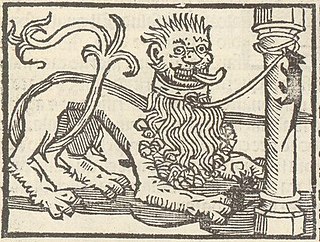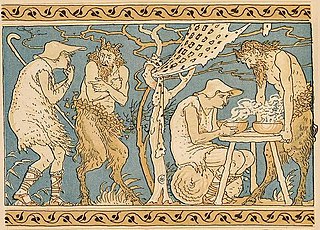
The bulls and the lion is counted as one of Aesop's Fables and is numbered 372 in the Perry Index. [1] Originally it illustrated the theme of friendship, which was later extended to cover political relations as well.

The bulls and the lion is counted as one of Aesop's Fables and is numbered 372 in the Perry Index. [1] Originally it illustrated the theme of friendship, which was later extended to cover political relations as well.
A lion keeps watch on a field in which two, three or four bulls are grazing. Knowing that they will group together to defend each other, the lion sows enmity between them so that they separate and he is able to kill them one by one. Early versions of the fable are in Greek, beginning with Babrius, [2] and there is a later latinised version by Avianus. [3] In the 4th century CE, the rhetorician Themistius introduced a variant in which it is a fox that brings discord so that the lion can profit from it. [4]
The moral given the story was generally to distrust a foe and hold fast to friends, but in the Syntipas version it was later given a political turn: "This fable shows that the same is true of cities and people: when they are in agreement with one another, they do not allow their enemies to defeat them, but if they refuse to cooperate, it is an easy matter for their enemies to destroy them." [5] A similar sentiment was taken up in the collection illustrated by the English artist Francis Barlow in 1665, where the story is applied to state alliances. [6] The lesson of holding fast to an alliance against the common foe was later repeated in a poem often reprinted during the American War of Independence, where there are 13 bulls in the field, the number of states in revolt. [7]
A much longer poem, praising friendship and describing how the fox brings division among the bulls through lies and flattery, accompanied the fable of "The Four Bulls" in Thomas Bewick's illustrated edition of 1818. [8] The poem had been taken from the series written by John Hawkesworth under the pseudonym H. Greville in The Gentleman's Magazine in 1741. [9] There the fable had been incorporated as one element in a didactic poem titled "The Whisperer". [10]

William Somervile or Somerville was an English poet who wrote in many genres and is especially remembered for "The Chace", in which he pioneered an early English georgic.

Aesop's Fables, or the Aesopica, is a collection of fables credited to Aesop, a slave and storyteller who lived in ancient Greece between 620 and 564 BCE. Of varied and unclear origins, the stories associated with his name have descended to modern times through a number of sources and continue to be reinterpreted in different verbal registers and in popular as well as artistic media.
The Deer without a Heart is an ancient fable, attributed to Aesop in Europe and numbered 336 in the Perry Index. It involves a deer who was twice persuaded by a wily fox to visit the ailing lion. After the lion had killed it, the fox stole and ate the deer's heart. When asked where it is, the fox reasoned that an animal so foolish as to visit a lion in his den cannot have had one, an argument that reflects the ancient belief that the heart was the seat of thoughts and intellect. The story is catalogued as type 52 in the Aarne-Thompson classification system.
The lion's share is an idiomatic expression which now refers to the major share of something. The phrase derives from the plot of a number of fables ascribed to Aesop and is used here as their generic title. There are two main types of story, which exist in several different versions. Other fables exist in the East that feature division of prey in such a way that the divider gains the greater part - or even the whole. In English the phrase used in the sense of nearly all only appeared at the end of the 18th century; the French equivalent, le partage du lion, is recorded from the start of that century, following La Fontaine's version of the fable.

The Monkey and the Cat is best known as a fable adapted by Jean de La Fontaine under the title Le Singe et le Chat that appeared in the second collection of his Fables in 1679 (IX.17). It is the source of popular idioms in both English and French, with the general meaning of being the dupe of another.

The Lion and the Mouse is one of Aesop's Fables, numbered 150 in the Perry Index. There are also Eastern variants of the story, all of which demonstrate mutual dependence regardless of size or status. In the Renaissance the fable was provided with a sequel condemning social ambition.
The Lion, the Bear and the Fox is one of Aesop's Fables that is numbered 147 in the Perry Index. There are similar story types of both eastern and western origin in which two disputants lose the object of their dispute to a third.

The Wolf and the Crane is a fable attributed to Aesop that has several eastern analogues. Similar stories have a lion instead of a wolf, and a stork, heron or partridge takes the place of the crane.
The Ass in the Lion's Skin is one of Aesop's Fables, of which there are two distinct versions. There are also several Eastern variants, and the story's interpretation varies accordingly.

The Fox and the Sick Lion is one of Aesop's Fables, well known from Classical times and numbered 142 in the Perry Index. There is also an Indian analogue. Interpretations of the story's meaning have differed widely in the course of two and a half millennia.
The Bear and the Gardener is a fable originating in the ancient Indian text Panchatantra that warns against making foolish friendships. There are several variant versions, both literary and oral, across the world and its folk elements are classed as Aarne-Thompson-Uther type 1586. The La Fontaine version has been taken as demonstrating various philosophical lessons.
The Ass and the Pig is one of Aesop's Fables that was never adopted in the West but has Eastern variants that remain popular. Their general teaching is that the easy life and seeming good fortune of others conceal a threat to their welfare.

The Satyr and the Traveller is one of Aesop's Fables and is numbered 35 in the Perry Index. The popular idiom 'to blow hot and cold' is associated with it and the fable is read as a warning against duplicity.

The Elm and the Vine were associated particularly by Latin authors. Because pruned elm trees acted as vine supports, this was taken as a symbol of marriage and imagery connected with their pairing also became common in Renaissance literature. Various fables were created out of their association in both Classical and later times. Although Aesop was not credited with these formerly, later fables hint at his authorship.

The Fox and the Weasel is a title used to cover a complex of fables in which a number of other animals figure in a story with the same basic situation involving the unfortunate effects of greed. Of Greek origin, it is counted as one of Aesop's Fables and is numbered 24 in the Perry Index.
The Fox and the Woodman is a cautionary story against hypocrisy included among Aesop's Fables and is numbered 22 in the Perry Index. Although the same basic plot recurs, different versions have included a variety of participants.

The Ape and the Fox is a fable credited to Aesop and is numbered 81 in the Perry Index. However, the story goes back before Aesop's time and an alternative variant may even be of Asian origin.

The Eagle and the Fox is a fable of friendship betrayed and avenged. Counted as one of Aesop's Fables, it is numbered 1 in the Perry Index. The central situation concerns an eagle that seizes a fox's cubs and bears them off to feed its young. There are then alternative endings to the story, in one of which the fox exacts restitution, while in the other it gains retribution for its injury.

"The Lion Grown Old" is counted among Aesop's Fables and is numbered 481 in the Perry Index. It is used in illustration of the insults given those who have fallen from power and has a similar moral to the fable of The dogs and the lion's skin. Parallel proverbs of similar meaning were later associated with it.

The Kite and the Doves is a political fable ascribed to Aesop that is numbered 486 in the Perry Index. During the Middle Ages the fable was modified by the introduction of a hawk as an additional character, followed by a change in the moral drawn from it.